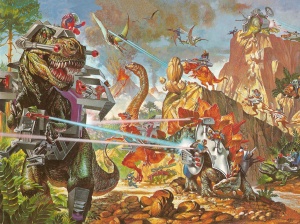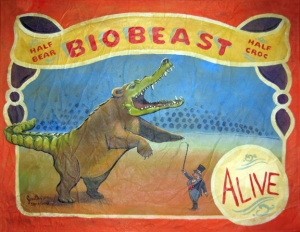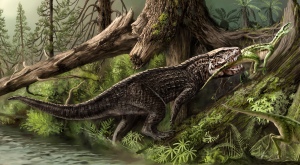In this week’s TotW, Ryan takes us through the posto child of the ‘rauisuchians’, Postosuchus.
When someone mentions the Mesozoic, you instantly think about dinosaurs. Admit it, it’s fine, there’s no judgement on this blog. You also will predominately think about dinosaurs from the Jurassic and the Cretaceous, with good old T. rex and co. (allosaurs, carcharodontosaurs, spinosaurs etc.) ruling the roost at the top of the food chain, whilst sauropod behemoths (amongst other ridiculously sized herbivores) wandering about in herds etc. etc. However, the Triassic (seemingly the Cretaceous and Jurassic’s ugly sister) is often forgotten about. Yes, we don’t have things which are outrageously large or ridiculously bipedal (or do we..?), but in the Triassic, crurotarsans (crocodile-line archosaurs) were having a bit of a field day.

The image that immediately springs to mind as soon as you mention ‘Jurassic’ or ‘Cretaceous’. Clearly.
Here on TDS, we think the Triassic (as well as plenty other eras, not just the Jurassic and Cretaceous) is pretty awesome too. The Triassic was a time of recovery, the Permian-Triassic mass extinction event had been and gone (and almost taken all of life on Earth with it). Dinosaurs were just starting out, and sitting on top of the food chain was, you guessed it, Postosuchus. If you look at the skull of Postosuchus kirkpatricki below, look carefully. Back in the 1980s famous palaeontologists thought Postosuchus (along with Poposaurus) could be a tyrannosaur ancestor. You can see where they’re coming from. Postosuchus was first discovered in 1922, and for 60 odd years after that, people didn’t really know what to make of it. First reports penned it as a Coelophysis, 20 years later, other finds were thought to belong to a new phytosaur. It wasn’t up until 1985 that the holotype, a well preserved skull and some postcranial remains, of Postosuchus kirkpatricki was formally announced.
Weighing in at almost 300kg, at reaching almost 4m when fully grown, Postosuchus was one (if not the) largest predator in the Triassic. With good long distance vision, a decent sense of smell, and a possible Jacobson’s organ, and oh, not to mention, over 7cm dagger-like teeth, this killing machine well may have taken down a fair few aetosaurs in it’s time (not a small feat). So fairly fearsome, but not as impressive as the theropods that were to come later in the Mesozoic, surely? Well, again, no.
What makes Postosuchus (and many other ‘rauisuchians‘) so interesting are its hindlimbs. One of the major dinosaurian innovations was the erect hindlimb posture, enabling more efficient locomotion. In the Triassic, descendants of crocodiles (who now have the ‘sprawling’ hindlimb posture) such as Postosuchus had a go at this hindlimb arrangement (evolutionary speaking). Whilst debated, many palaeontologists view Postosuchus (amongst other Triassic crurotarsans) as being bipeds (or at the very least facultative bipeds). So that means Postosuchus could use it’s forelimbs to kill things as well as it’s terrifyingly huge mouth (like bears do). To summarise, Postosuchus is a nightmare-inducing, killer croc-bear from back in time. It also raises the question (to be investigated by a future blog post on TDS, hopefully) of why exactly did dinosaurs survive through to the Jurassic, and rauisuchians go extinct, and why did crurotarsans go back to being solely quadrupedal?
Told you the Triassic was awesome. (Also, more to come on the locomotory strategies of Triassic crurotarsans to come, right after I finish my final 4th year exams…).
Bonus picture (because it’s cool and reasonably accurate, although not as accurate as the previous picture):
References
- Case, E. C. (1922). “New reptiles and Stegocephalians from the Upper Triassic of western Texas”. Carnegie Institution of Washington Publication 321: 1–84.
- Case, E. C. (1932). “On the caudal region of Coelophysis sp. and on some new or little known forms from the Upper Triassic of western Texas”. University of Michigan Museum of Paleontology Contributions 4 (3): 81–91.
- Case, E. C. (1943). “A new form of Phytosaur pelvis”. American Journal of Science 241 (3): 201–203. doi:10.2475/ajs.241.3.201.
- Chatterjee, S. (1985). “Postosuchus, a new Thecodontian reptile from the Triassic of Texas and the origin of Tyrannosaurs”. Philosophical Transactions of the Royal Society of London. Series B, Biological Sciences 309 (1139): 395–460. doi:10.1098/rstb.1985.0092.
- Drymala, S. & Bader, K. (2012). Assessing predator-prey interactions through the identification of bite marks on an aetosaur (Pseudosuchia) osteoderm from the Upper Triassic (Norian) Chinle Formation in Petrified Forest National Park (Arizona, USA). Journal of Vertebrate Palaeontology, Program and Abstracts 2012, p89.




